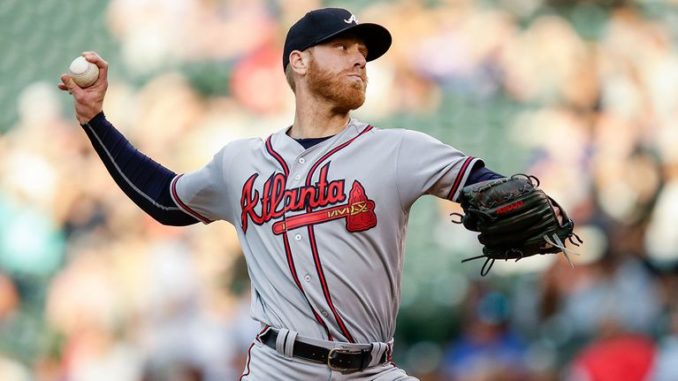
It seems only appropriate as pitchers and catchers start reporting to the Braves spring training complex that the Braves System Depth series turns to the starting pitching. Pitching overall has been a primary focus of the rebuild, and while some of the early returns haven’t given the team the boost the front office was hoping for, the more high-ceiling talents are now starting to matriculate to the majors. Braves fans got tantalizing looks at the likes of Sean Newcomb, Max Fried, Lucas Sims, and Luiz Gohara last season, and more reinforcements should push their way to the big leagues this season. The success rate of these pitchers are the critical component in determining if the rebuild will ultimately be successful.
For this reason, unlike the prior several years there are very few veteran non-roster invitees on minor league deals. The Braves are taking the training wheels off their minor league pitching depth.
ALSO IN THIS SERIES:
First Base
Second Base
Third Base
Shortstop
Catcher
Left Field
Centerfield
Right Field
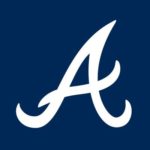 ATLANTA BRAVES
ATLANTA BRAVES
PROJECTED ROTATION:
RHP Julio Teheran
The Atlanta rotation is likely to be a notch below major league average, but contains enough intrigue that it’s possible they will perform better than estimates. It starts with the 27-year-old veteran of the staff, Julio Teheran, who is coming off his worst season since establishing himself as a major leaguer. This was primarily due to the amplification of his two worst career trends, giving up home runs and having trouble with left-handed hitters. Both of those trends improved dramatically in the final two months of 2017, as Teheran nearly abandoned throwing his sinker and slider to left-handers and went primarily with his four-seam fastball and change-up. Teheran is a pitcher who is constantly re-inventing himself, and how he continues to adapt to changes in how hitters work him, his new home ballpark, and his own stuff changing as he ages will go a long way to determining the fortunes of not just him but the whole pitching staff.
RHP Mike Foltynewicz
Foltynewicz has been the best of the first wave of the rebuild pitchers, but has be maddeningly inconsistent as well. However, for most of last season, it seemed that Foltynewicz was taking a big step toward being that dependable mid-rotation starter the organization and fans have been hoping for. The highlight of his season, and perhaps the whole team’s, was the near-no-hitter he threw on June 30 against Oakland. However, his season started to unravel in August, then was interrupted with a finger injury in September. Foltynewicz’s issues mirror Teheran’s in some ways; he’s been susceptible to giving up home runs, and he has trouble with left-handed hitters. Foltynewicz’s pitching arsenal is formidable, but he runs into bad innings where everything seems to run straight over the plate. Hopefully a publicized pep-talk with recent Braves Hall-of-Famer Tim Hudson on finishing off hitters will have an impact.
LHP Sean Newcomb
Newcomb was the first man up for the Braves when Bartolo Colon faltered. Newcomb’s bugaboo throughout his pro career has been a lack of control, but despite elevated walk numbers, Newcomb seldom seemed to be out of control for either Gwinnett or Atlanta in 2017. Instead, Newcomb seems to get into trouble when he tries to nibble, a frustrating tendency for a pitcher who has been remarkably difficult to square up the last two seasons. Newcomb has demonstrated all of the ingredients to be a quality major league starting pitcher, now the 24-year-old will look to consistently bring them all to the mound for every batter of every inning of every start.
RHP Brandon McCarthy
A newcomer to the Braves rotation, righty Brandon McCarthy will look to bring “veteran presents” to a young staff. McCarthy battled through shoulder and blister issues for most of 2017, but came back in time to make the postseason roster for the Dodgers. When he is healthy, McCarthy is a solid mid-rotation option, though he hasn’t made 30 starts in a season since 2014.
LHP Luiz Gohara (See also: Prospect Analysis)
Gohara is by most accounts either the top or one of the top current Braves pitching prospects. He blitzed the minor league system last year, rising from high-A all the way to the major leagues in September. Gohara has an electric fastball/slider combination, and he was clocked as the fastest-throwing left-handed pitcher in the majors last season. Gohara’s challenge this season will be to improve his change-up in order to give hitters a different look; while there’s been some successful two-pitch starters in the major leagues, it’s like threading the eye of a needle to make it work all the time.
OTHER OPTIONS:
LHP Scott Kazmir
Kazmir has had one of the more interesting major league careers you can find, but all signs show that it could be the end of the road for the 34-year-old. Kazmir missed all of the 2017 season battling what was termed to be hip tightness. The ailment robbed the 14-year-vet of his velocity. He’s coming into camp this season to see if he has anything left. If he does, he’s an option for either the rotation or the bullpen.
RHP Chase Whitley
Claimed off waivers from Tampa in December, Whitley was primarily a swingman though his pro career though the Rays used him exclusively out of the bullpen at the major league level of 57 innings last year. Whitley is a fairly classic fastball/slider/change righty, and he’ll add a below average curveball to the repertoire when he starts to give hitters another look.
 GWINNETT STRIPERS (CLASS AAA)
GWINNETT STRIPERS (CLASS AAA)
PROJECTED ROTATION:
LHP Max Fried (See also: Prospect Analysis)
Perhaps no pitcher is coming into camp with a more wild variance in possible outcomes as to role or level than Fried. While I am projecting him to the Gwinnett rotation, he’s at least as much of a chance that he will start in the majors. After a solid major league debut at the end of 2017 and a dominating performance in the Arizona Fall League, Fried could find himself in either the rotation if one of the projected options doesn’t pan out, or in the big league bullpen. No matter where he goes, Fried will be looking to keep the fastball command and movement he demonstrated late in 2017, and stay away from the blister issues that ruined most of his season at AA Mississippi.
RHP Lucas Sims
Like Gohara and Fried, Sims made his major league debut late in 2017. His surface numbers look worse than his actual pitching, and are effected by two rough starts. Sims has a good rising fastball, a good sharp curveball, and a good change-up; the question is will he be able to hit his spots consistently. He seemed to do better at that pitching out of the bullpen, and he held opponents to a .227/.292/.364 batting line against in his limited look as a reliever. Perhaps more than Fried, Sims has a strong shot at breaking camp with Atlanta out of the ‘pen.
RHP Mike Soroka (See also: Prospect Analysis)
Soroka was dominant in AA Mississippi in 2017, despite pitching most of the season as a 19-year-old. This spring will be his first big league camp invite, and if someone can be a dark horse favorite for someone pitching well enough to force the organization to consider them, many folks including this writer would choose Soroka. His pitching intelligence is higher than his years on the planet would indicate, and he’s got four solid pitches that could probably get out big league hitters now. For experience sake however, he will almost certainly start the year with the Stripers, but of all of the top prospects he seems the mostly likely get a Sean Newcomb-style early call-up.
LHP Kolby Allard (See also: Prospect Analysis)
Another 19-year-old that had success in AA last year, Allard’s prospect status has been oddly in flux this offseason. Some scouts and prospect pundits are concerned about how much his fastball velocity backed up over the course of the season, along with some curveball command issues and the general lack of projection left in his frame. While those are all valid concerns, stepping back just a bit and you still have a teenaged left-handed starter who successfully competed his first full season of pro ball at AA and learning how to make it through a complete season. He will likely start in AAA this season, and while he likely needs more polishing than the pitchers listed ahead of him, he should also make his major league debut at some point this season.
RHP Manny Barreda
Barreda signed a minor league deal with the Braves back in 2016 and was on loan to the Tijuana Toros of the Mexican League. He threw a 138-pitch no-hitter for the Mexican Winter League’s Cañeros de Los Mochis in November 2016, and unsurprisingly his arm started bothering him shortly afterward. The Braves shut him down for the first half of last season, but he came on to pitch in 7 starts for Gwinnett late in the year and made an impression, pitching to a 1.83 ERA.
OTHER OPTIONS:
RHP Aaron Blair
Acquired as part of the package from Arizona for Shelby Miller before the 2016 season, Blair was a consensus top 100 prospect and someone who was deemed close to ready for the majors when the Braves traded for him. The Braves put that thinking to the test when he was brought to the majors in 2016. Other than a couple of good starts however, Blair has been a disappointment so far, owning 7.89 major league ERA in 73 innings. Blair struggled in AAA last year as well, and only made one appearance for the big league club. As the cherry on top of the crap sundae that was his 2017, Blair tore his lat muscle on the last day of the season. Blair has reportedly lost around 40 pounds this offseason in an effort to better his game, but he needs better fastball command and better movement on his slider to be a true major league option.
RHP Patrick Weigel
Weigel was on a path to make his major league debut last season when he tore his UCL in mid-June, requiring the dreaded Tommy John surgery. The Braves typically go through a 16-to-18-month rehab schedule, so it would be a surprise if Weigel got back to a mound for anything but rehab appearances in 2018, and I am including him here mostly for completeness sake.
RHP Matt Wisler
After a promising debut with Atlanta in 2015, Wisler has not been able to establish himself as either a big league pitcher or even as a starting pitcher. Last season, the Braves started what looks like a possible permanent move for Wisler to the bullpen, and he didn’t start a game for with Atlanta or Gwinnett after July 29. In the bullpen, his normally 92-94 mph fastball plays up to the high 90’s. The key to success for Wisler as a reliever however is if he can command his slider, which at times has been a dominant pitch. If the Braves elect to move him back to the rotation, Wisler will need to improve on a third pitch, as both his curveball and change-up have been hit hard in the majors.
RHP Kyle Wright (See also: Prospect Analysis)
While I am projecting Wright to start the season with AA Mississippi, given that he’ll be in big league camp on a non-roster invitation and his overall pedigree, there is a possibility the Braves first round pick last season could start the season in AAA. It’s likely a lot more will have to happen ahead of him for this to happen however, though if it were I don’t expect Wright to be overmatched.
OFR TOP 10 STARTING PITCHER PROSPECT RANKINGS:
- Mike Soroka
- Luiz Gohara
- Kyle Wright
- Kolby Allard
- Ian Anderson
- Max Fried
- Touki Toussaint
- Bryse Wilson
- Joey Wentz
- Patrick Weigel

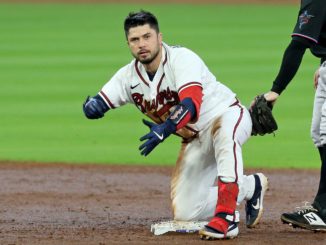
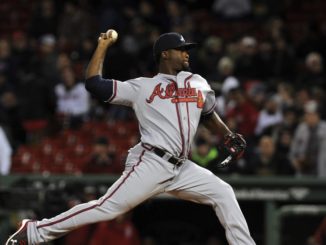
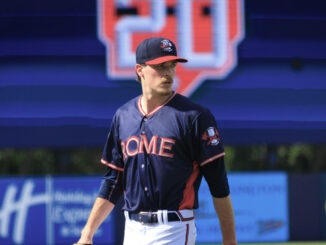
The Braves have a bright future with all the young, high ceiling pitching we have coming up the system.
I project our 2019 Opening Day Rotation to be the following:
1. Mike Folty (Teheran will probably be traded by The Trade Deadline)
2. Luiz Gohara
3. Mike Soroka
4. Kolby Allard
5. Kyle Wright
2020 Opening Day Starting Rotation:
1. Luiz Gohara
2. Mike Soroka
3. Kolby Allard
4. Kyle Wright
5. Tooki Tousiant/Bryce Wilson/Joey Wentz/Ian Anderson
2021 Opening Day Starting Rotation:
1. Luis Gohara
2. Mike Soroka
3. Kyle Wright
4. Bryce Wilson
5. Ian Anderson
It is possible that by 2021, a productive Kolby Allard will have to be traded to make room for even more talented Bryce Wilson and Ian Anderson (Joey Wentz may have to be traded also….because he may not have room either, lol).
I would rather our GM, AA, wait until AFTER our rotation is built BEFORE trading from our ‘surplus’ of pitching prospects. A lot of fans today seem to want AA start trading TODAY (when our rotation is FAR from being built).
While I feel comfortable with the above projections….I’ve been watching MLB long enough to understand that injuries/variance/attrition/inability to get MLB hitters out/etc. all play a part in unexpectedly ruining many a bright prospect’s career. That’s why it makes LITTLE SENSE to start trading pitching prospects today! Just wait…..if I’m wrong about the above projections, then it would be nice to have reserve prospects in place to fill The Rotation!